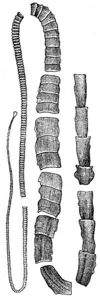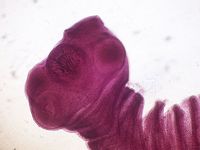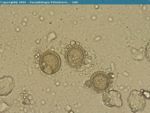Difference between revisions of "Taenia"
| Line 186: | Line 186: | ||
'''Intermediate host''': sheep, and goats. | '''Intermediate host''': sheep, and goats. | ||
'''Definitive host''': dogs and foxes. | '''Definitive host''': dogs and foxes. | ||
| + | |||
| + | ==Identification== | ||
| + | ''T. ovis'' is a large tapeworm, usually around 1m in length. It has numerous hooks. | ||
| + | |||
| + | ==Life Cycle== | ||
| + | The intermediate host ingests cysticercus, which hatch in the intestine and later infect the skeletal muscle and the heart. The definitive host becomes infected by ingestion of the intermediate host. | ||
| + | |||
| + | The prepatent period for ''T. ovis'' is 6-9 months. | ||
*Cysticerci occur in the musculature of sheep = condemnation of meat on aesthetic grounds. | *Cysticerci occur in the musculature of sheep = condemnation of meat on aesthetic grounds. | ||
*Common in some sheep-raising areas of the UK. | *Common in some sheep-raising areas of the UK. | ||
Revision as of 11:00, 18 July 2010
| This article is still under construction. |
Introduction
Like most adult tapeworms, Taenia species live in the small intestine. The different species vary in length from 0.5-15m long. Identification is based on the hooks on the scolex. Despite their impressive size, the adult tapeworms of little clinical significance. The metacestodes of some species, however, may cause disease or meat inspection losses. The human pork tapeworm, Taenia solium, is a dangerous zoonosis but, fortunately, it does not occur in the UK.
Scientific Classification
| Kingdom | Animalia |
| Phylum | Platyhelminthes |
| Class | Cestoda |
| Order | Cyclophyllidea |
| Family | Taeniidae |
| Genus | Taenia |
| Taenia | Final Host | Intermediate Host | Metacestode | Obsolete Name for Metacestode |
|---|---|---|---|---|
| T. saginata | Human | Cattle | Cysticercus in muscle | C. bovis |
| T. solium | Human | Pig | Cysticercus in muscle | C.cellulosae |
| T. ovis | Dog | Sheep | Cysticercus in muscle | C. ovis |
| T. hydatigena | Dog | Sheep etc. | Cysticercus in peritoneum | C. tenuicollis |
| T. pisiformis | Dog | Rabbit | Cysticercus in peritoneum | C. pisiformis |
| T. multiceps | Dog | Sheep | Coenurus (various sites) | C. cerebralis |
| T. serialis | Dog | Rabbit | Coenurus (various sites) | C. serialis |
| T. taeniaeformis | Cat | Mouse etc. | Strobilocercus in liver | S. fasciolaris |
Nomenclature of Metacestodes
The preferred nomenclature is, for example, “the metacestode of Taenia hydatigena”.
Taeniid Eggs
Have a striated “shell”, and are small (half the size of a strongyle egg). The six hooks of the tapeworm larva (oncosphere) are sometimes visible inside the egg. One or more gravid segments, each containing some 150,000-250,000 eggs, are shed daily and pass out of the anus. Eggs are released into the environment by the motile segments.
Taenia spp of Humans
T. saginata
| Also known as: | Cysticercus bovis
|
Hosts
Definitive host: Man. Intermediate host: Cattle.
Identification
The adult is only found in humans, and is normally 5m in length, but may grow up to 3 times the length. The body is white and has a prominent anterior scolex, but no hooks.
The Proglottid has a thich outer shell, containing several hundred thousand eggs.
Life Cycle
Eggs are past by the host, and survive on the pasture. The oncosphere is then ingested by the intermediate host, the cow in this case. These infect the striated muscle, which are visible as cysts. Humans become infected by ingestion of poorly cooked meat.
Cysticerci
Grow to approximately 1cm long in the bovine intermediate host. If acquired during calfhood = survive; if acquired in later life eventually die = caseous = calcified. May be found in any striated muscle, but the highest densities are in heart and masseters.
Epidemiology
May differ from place to place. For example: - In the UK, very low prevalence in human population + generally high standards of sanitation = low transmission rate to cattle = low general prevalence in cattle = no herd immunity = sporadic “cysticercoid storms”. - In East Africa, high prevalence in human population + lack of sanitation in rural areas = high rate of transmission to cattle = many calves infected = calfhood infection persists, but animals immune to reinfection.
T. solium
| Also known as: | Cysticercus cellulosae
|
Hosts
Intermediate host: Pig, and also occasionally the dog and man. Definitive host: Man.
Identification
The adults are 3-5m in length, have a scolex, and several rows of hooks.
Life Cycle
The life-cycle is similar to that of T. saginata, except now the pig is the intermediate host. Gravid segments, containing the parasite eggs are passed in faeces. The oncospheres are then ingested by the intermediate host, in this case the pig, and pass into the blood system, infecting striated muscles. The cysticerci may also develop in the lungs, liver, kidney and the brain. Like T. saginata, humans, which are the definitive host becomes infected via ingestion of poorly cooked meat.
Taenia spp of the Dog
- Several species occur in dogs, varying in length from approximately 0.5-5m.
- Some species may also occur in the fox.
- The adults live in the small intestine and appear to cause little harm, but the exiting proglottids may cause pruritus.
- The prevalence of each species varies in different groups of dogs depending on their diet, that is, whether or not they have access to fresh meat, offal or rabbits.
- The prepatent period is generally 6-8weeks.
- It is important to differentiate the gravid proglottids of Taenia from those of Dipylidium. Taenia segments:
- are rectangular
- there is only one lateral genital pore
- the eggs are single (i.e. not in packets like Dipylidium)
T. ovis
| Also known as: | Cysticercus ovis
|
Hosts
Intermediate host: sheep, and goats. Definitive host: dogs and foxes.
Identification
T. ovis is a large tapeworm, usually around 1m in length. It has numerous hooks.
Life Cycle
The intermediate host ingests cysticercus, which hatch in the intestine and later infect the skeletal muscle and the heart. The definitive host becomes infected by ingestion of the intermediate host.
The prepatent period for T. ovis is 6-9 months.
- Cysticerci occur in the musculature of sheep = condemnation of meat on aesthetic grounds.
- Common in some sheep-raising areas of the UK.
- Known as ‘sheep measles’ in Australasia, where it causes economic loss to the export industry.
- Consequently, a recombinant oncosphere antigen vaccine is available in New Zealand.
T. hydatigena
- The commonest species in the UK.
- Sheep are the most frequent intermediate host, but the cysticerci can establish in other animals.
- The oncosphere hatches out of the egg in the small intestine of the sheep.
- Oncospheres travel to the hepatic portal system, where they transform to cysticerci.
- The grow rapidly while migrating through liver parenchyma, then to the peritoneal cavity.
- The cysticerci in the peritoneal cavity are approximately 8cm long; often found adhering to the omentum.
- Usually, liver damage heals, forming fibrotic tracts, which leads to condemnation at meat inspection.
- If a sheep swallows a whole proglottid, it leads to liver damage, and ultimately death (“cysticercosis hepatica”), but this is a rare event affecting a single animal in a flock.
T. pisiformis
- It is similar to T. hydatigena, except that the cysticerci are pea-sized and are found on the omentum of rabbits.
T. multiceps (also known as Multiceps multiceps)
- Widespread distribution in the UK; particularly common in parts of mid-Wales.
- The eggs hatch in the small intestine of the sheep.
- The oncosphere enters the blood stream and travels to the brain, where it migrates through brain tissue.
- The metacestode (a coenurus) occurs inside the skull, lying on the surface of the brain.
- It forms a 5cm long space occupying lesion.
- This leads to neurological signs, including gid – circling, ataxia and blindness.
- It also causes softening of the skull above the lesion.
- If a whole proglottid is ingested, it can lead to acute encephalitis (very rare).
T. serialis
- The coenurus forms in intermuscular connective tissues of rabbits, often causing a soft subdermal swelling.
- Cases in pet rabbits probably originate from eggs shed by urban foxes.
Taenia spp of the Cat
T. taeniaeformis
- The metacestode appears as a pea-sized nodule in the liver of mice and other small rodents.
- Cats will continue to become re-infected if they are hunters.
Peritoneal Cavity - Parasitic Pathology inhabited by Taenia hydatigena, Taenia pisiformis, Taenia ovis
- Taenia solium and T.ovis, T. saginata, Multiceps serialis in myositis



